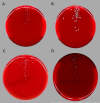Evaluation of the WASPLab Segregation Software To Automatically Analyze Urine Cultures Using Routine Blood and MacConkey Agars
- PMID: 31941690
- PMCID: PMC7098764
- DOI: 10.1128/JCM.01683-19
Evaluation of the WASPLab Segregation Software To Automatically Analyze Urine Cultures Using Routine Blood and MacConkey Agars
Abstract
Automation of the clinical microbiology laboratory has become more prominent as laboratories face higher specimen volumes and understaffing and are becoming more consolidated. One recent advancement is the use of digital image analysis to rapidly distinguish between chromogenic growth for screening bacterial cultures. In this study, colony segregation software developed by Copan (Brescia, Italy) was evaluated to distinguish between significant growth and no growth of urine cultures plated onto standard blood and MacConkey agars. Specimens from 3 sites were processed on a WASP instrument (Copan) and incubated on the WASPLab platform (Copan), and plates were imaged at 0 and 24 hours postinoculation. Images were read by technologists following validated laboratory protocols (VLPs), and results were recorded in the laboratory information systems (LIS). Image analysis performed colony counts on the 24-hour images, and results were compared with the VLP. A total of 12,931 urine cultures were tested and analyzed with an overall sensitivity and specificity of 99.8% and 72.0%, respectively. After secondary review, 91.1% of manual-positive/automation-negative specimens were due to expert rules that reported the plate as contaminated or growing only normal flora and not due to threshold counts. Nine specimens were found to be manual-positive/automation-negative; a secondary review demonstrated that the results of 8 of these specimens were due to growth of microcolonies that were programmed to be ignored by the software and 1 were due to a colony count near the limit of significance. Overall, the image analysis software proved to be highly sensitive and can be utilized by laboratories to batch-review negative cultures to improve laboratory workflow.
Keywords: automation; image analysis; urine culture.
Copyright © 2020 American Society for Microbiology.
Figures

Comment in
-
Machine Learning Takes Laboratory Automation to the Next Level.J Clin Microbiol. 2020 Mar 25;58(4):e00012-20. doi: 10.1128/JCM.00012-20. Print 2020 Mar 25. J Clin Microbiol. 2020. PMID: 32024725 Free PMC article.
References
MeSH terms
Substances
LinkOut - more resources
Full Text Sources

